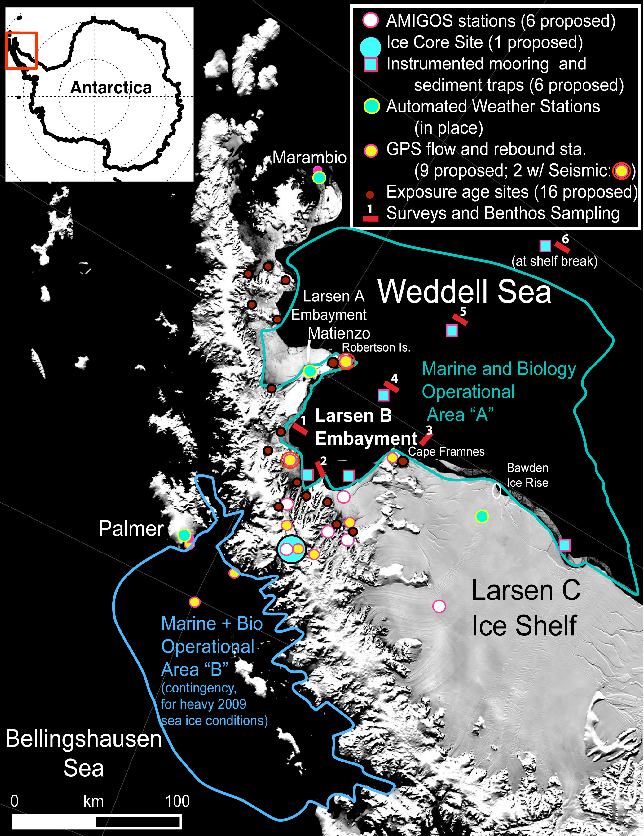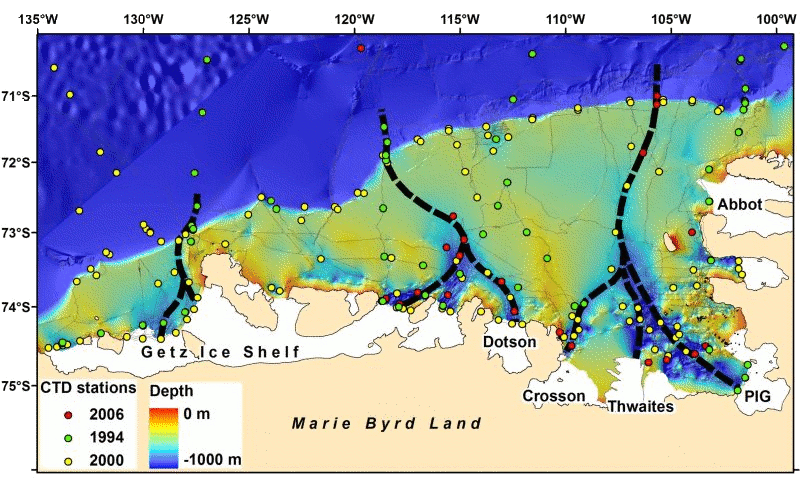IPY 2007-2008 Funded Research
Abrupt Environmental Change in the Larsen Ice Shelf System
In 2002, a 3200 square kilometer section of the Larsen B Ice Shelf along the Antarctic Peninsula disintegrated in less than one month, precipitating dramatic changes in the physical and biological environments. The breakup of the Larsen B ice shelf followed a rapid, intense period of climate warming that is still ongoing and will likely induce the breakup of more shelf area in the future. All these systems - glacial, geologic, biologic, and oceanographic, continue to evolve A multi-institutional, multinational effort, this project will place instruments in the area and make measurements from ships over a period of 3 years to study these evolving, tightly inter-linked systems. The
research team includes scientists from Lamont, Hamilton College, Colgate University, Montclair State University, Southern Illinois University, Ohio State University, University of California-San Diego, University of Alaska, the University of Colorado at Boulder, Portland State University, Duke University, University of Hawaii, University of Houston, Canada, Argentina, Belgium, and Germany. Lamont PIs: Arnold Gordon and Bruce Huber.
[more]
|
 |
 |
Ocean Contributions to Atmospheric Warming
The region west of the Antarctic Peninsula has shown considerable atmospheric warming, particularly in winter, over recent decades, impacting the ecosystem in many ways. 87% of the glaciers are in retreat on the peninsula; part of the West Antarctic Ice Sheet that if melted can contribute a little more to sea level rise than the melting of Greenland's ice sheet. As the predominant source of heat in the winter the ocean is implicated in this warming. IPY research uses moorings to measure water temperature at key locations in the ocean in order to study the flow and behavior of warm ocean water onto the continental shelf from upstream sources. PI: Doug Martinson.
|
Glacial Melt and Sea Level Rise in the Amundsen Sea
Bathymetry and locations of ocean profiles in the Amundsen Sea, minus its perennial sea ice cover, mostly resulting from late austral summer cruises by Lamont investigators from 1994-2006. Those studies have revealed deep, glacially scoured troughs on the inner continental shelf, filled with 'warm' water that intrudes near the sea floor and reaches under the deep-draft floating ice shelves. This leads to melting 100 times faster than elsewhere around Antarctica, and ice shelf thinning that is believed to allow incoming glaciers to accelerate. In the Amundsen sector, glacier ice is moving into the sea faster than it is being replaced by snowfall, making a significant contribution to sea level rise. During the IPY, Lamont scientists and their UK and German collaborators will moor instruments along the apparent pathways of the deep water inflows (black dashed lines) to obtain multiyear records of temperature, salinity and ocean currents. Other plans include the use of an Autonomous Underwater Vehicle to map conditions within ice shelf cavities, and numerical modeling of the regional ocean circulation. PI: Stan Jacobs.
|

|
|
|
